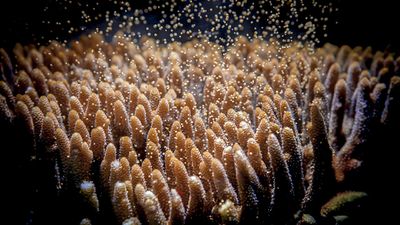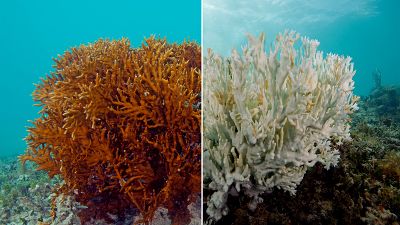Coral restoration
Introduction
Corals are types of marine invertebrates that act as keystone species for one of the most biodiverse ecosystems on Earth, coral reefs. Corals are made up of tiny organisms called polyps. The gathering of thousands of polyps is what creates a coral colony which are the structures we typically think of when we picture a coral. These coral colonies are what form coral reefs. The polyps use symbiosis not just for nutrients but to form the coral skeleton that is made of calcium carbonate. Corals obtain nutrients via coral symbiosis and photosynthesis. However, this photosynthesis is only occurring because of the algae attached to the coral and not the coral itself. Symbiosis occurs with Symbiodinium algae, or zooxanthellae, where the coral acts as the host and obtains fixed organic carbon from the algae while the algae receives inorganic nutrients recycled from the coral’s metabolism [1]
Mass bleaching events triggered by changing water temperatures and ocean acidification has spurred a rapid decline in coral populations. Bleaching is essentially the loss of the microbial symbionts that coral hosts rely on for nutrients and it often leads to the coral’s death. Because of the resources coral reefs provide for much of marine life, coral biology and conservation has become an area of focus for scientists. There have been many studies that have looked at the different factors contributing to coral decline from higher temperatures to coral disease. Scientists are also researching ways to aid active coral restoration by incorporating genetics or examining the potential of microbes.

Using Genetics in Coral Restoration
In recent years, biologists have been attempting to engineer new breeds of heat-tolerant coral, specifically by breeding hybrids through cross-breeding [2]. Hybridization creates new gene combinations and increases genetic diversity, which can possibly enhance adaptation under new environmental conditions. The fitness of a hybrid relative to the parental species can depend on the gene effect. If the gene effect is additive or over-dominant, the fitness of the hybrid is higher than one or both parents [3]. There has been previous research to suggest that interspecific hybrid corals, particularly of Acropora, have had higher fitness than purebred corals and, in the lab, have shown resilience under elevated temperatures [4]
Research conducted recently at AIMS used seven parental species of Acropora to ask whether hybrid Acropora larvae had enhanced survivorship and settlement success compared to the purebreed larvae under ambient and elevated temperatures[4]. There are barriers to fertilization however, called prezygotic barriers. This study in particular noted gametic incompatibility and temporal isolation as possible barriers preventing interspecific hybridization in the wild. In temporal isolation of coral, two populations cannot interbreed because they release their gametes at different times, i.e. ‘early spawners’ and ‘late spawners’. In this study, gametic incompatibility was a stronger barrier than temporal isolation and this strength varied between species pairs and the hybrid cross direction. Survival of the hybrid offspring groups was higher or equal to the purebreed offspring, although fertilization rates were lower. Hybrid offspring were also able to settle normally under elevated temperatures. Overall, hybrid offspring demonstrated resilience that could be useful in adapting to climate change. Further research is needed to assess the reproductive success of future hybrid generations.
A recent study reported successful use of the CRISPR-Cas9 gene-editing tool on coral. CRISPR-Cas9 is generally used to introduce changes to genes in the genome, and is a promising tool for the treatment and prevention of human diseases [5]. This study generated loss-of-function mutations into three genes of Acropora millepora. They targeted the gene encoding fibroblast growth factor 1 (FGF1a), green fluorescent protein (GFP), and red fluorescent protein (RFP). FGF1a encodes an FGF-signaling ligand, which previous studies have suggested plays a role in sensing the environment or modulating gene expression during larval settlement and metamorphosis [6]. GFP and RFP are highly expressed in larvae and responsive to environmental disturbances. Over two nights of spawning, freshly fertilized zygotes were injected either with two or three sgRNA/Cas 9 complexes or with Cas9 protein alone as a control. At least half of the successfully injected larvae had been induced by mutations at the predicted target site. Such presence of mutations suggests high efficiency of genomic editing. Future CRISPR-Cas9 studies are needed to understand gene function in coral focusing on target genes that are likely to give detectable phenotypes. Overall, CRISPR may become an important tool for coral restoration by knocking out genes to identify those that control how coral handles high temperatures and stress [2].
The Role of Microbial Symbionts
Symbiosis occurs with Symbiodinium algae, or zooxanthellae, where the coral acts as the host and obtains fixed organic carbon from the algae while the algae receives inorganic nutrients recycled from the coral’s metabolism [1]. Coral reef bleaching is seen as the main driver of coral decline. Bleaching is the loss of symbionts due to a stressor like high temperatures. In these environmental extremes, coral will be unable to provide for the zooxanthellae and will expel the algae. High temperatures damage the photosynthetic mechanisms of the host’s algae, resulting in overproduction of oxygen radicals [7]. This eventually leads to cellular damage, and the expulsion of symbionts to increase survivorship of the host. With the breakdown of symbiosis, coral no longer obtain nutrients.
In recent years, studies have realized the flexibility and diversity of these symbionts. Different species of coral have been shown to contain multiple clades of symbionts. There has been an “adaptive” response to bleaching by increasing heat-tolerant symbionts through symbiont shuffling, or changing symbiont community composition. Many coral taxa are capable of hosting multiple types, so this may possibly play an important role in coral recovery. A 2015 experiment tested the Adaptive Bleaching Hypothesis (ABH) which predicts that partner-switching following a bleaching event may occur by recovery with different symbionts that are better suited to the prevailing conditions [8]. The study monitored symbiont shuffling after bleaching recovery at 24°C and 29°C with the prediction that more severe bleaching and a warmer recovery environment promote shuffling towards heat-tolerant symbionts. Shuffling occurred between clades D and B, which refer to different branches of symbionts that share common ancestry. High stress increased proportions of Symbiodinium clade D after recovery, especially at 29°C. Their results reflected the prediction that heat-tolerant symbionts are likely to become dominant after severe bleaching, especially in warmer recovery temperatures. Evidence against the ABH is based on the mass mortality of reef corals following a bleaching event along with a lack of evidence for natural partner recombination. However, the ability of reef corals to become dominated by different symbionts following a bleaching event has been seen in different field experiments [9].
Also, microbial symbionts may have a more rapid capability for adaptation than their coral hosts that have a sexual generation time of 4-8 years, which may be too long for genetic adaptation to keep up with climate change. Within-generational acclimatization and transgenerational epigenetic changes are possible, and can be further enabled by changes in the associated microbial symbionts [10]. These rapidly dividing microbes will undergo adaptive evolution faster than genetic adaptation at a population level for their coral hosts. Acclimatization can occur via microbial frequency shifts (symbiont shuffling), acquiring new microbial strains (symbiont switching), or horizontal gene transfer. Under increasing temperatures, symbionts may increase or decrease in frequency, altering fitness and function of the holobiont (the assemblage of the coral, Symbiodinium, associated bacteria and viruses). Studies have seen these community shifts via increased abundance of certain Symbiodinium clades such as heat-tolerant clade D1 in corals exposed to elevated temperatures [10]. However, shifts in a diverse symbiont population can be deleterious to the host and competition between symbiont genotypes can reduce energy needed for translocation to the host [11].

Conclusion
Understanding the decline of coral reefs starts with understanding the foundation of these reefs. Multiple studies over the past couple decades have shown that climate change has had a great effect on coral biology. Active coral restoration that looks at incorporating genetics and microbiology is a relatively new field, and more studies are needed to further understand coral genetics and the complex role of microbial symbionts. However, these strategies along with others such as micro-fragmentation or marine protected areas (MPAs) can aid coral restoration. Perhaps most importantly, these possible solutions will need to be doable for local and regional management. Further research is needed to understand how to best implement such methods for restoration.
References
- ↑ 1.0 1.1 Putman H., Barott K., Ainsworth T., Gates R. 2017. The vulnerability and resilience of reef-building coral. Current Biology. Volume 27. Issue 11. pp. R528-R540.
- ↑ 2.0 2.1 CornwallMar, Warren, et al. Researchers Embrace a Radical Idea: Engineering Coral to Cope with Climate Change. Science, 21 Mar. 2019
- ↑ Chan, Wing Yan, et al. Interspecific Hybridization May Provide Novel Opportunities for Coral Reef Restoration. Frontiers in Marine Science, vol. 5, 2018, doi:10.3389/fmars.2018.00160.
- ↑ 4.0 4.1 Chan, W.Y., Peplow, L.M. & Oppen, M.J.H. Interspecific gamete compatibility and hybrid larval fitness in reef-building corals: Implications for coral reef restoration. Sci Rep 9, 4757 (2019) doi:10.1038/s41598-019-41190-5
- ↑ “What Are Genome Editing and CRISPR-Cas9? - Genetics Home Reference - NIH.” U.S. National Library of Medicine, National Institutes of Health
- ↑ Cleves, Phillip A., et al. CRISPR/Cas9-Mediated Genome Editing in a Reef-Building Coral. Proceedings of the National Academy of Sciences, vol. 115, no. 20, 2018, pp. 5235–5240., doi:10.1073/pnas.1722151115
- ↑ Baker A.C., Glynn P.W., Riegl B. 2008. Climate change and coral reef bleaching: An ecological assessment of long-term impacts, recovery trends and future outlook. Estuarine, Coastal and Shelf Science. Volume 80. Issue 4. pp. 435-471
- ↑ R. Cunning, R. N. Silverstein, A. C. Baker. 2015. Investigating the causes and consequences of symbiont shuffling in a multi-partner reef coral symbiosis under environmental change. Proceedings of the Royal Society B: Biological Sciences. Volume 282. Issue 1809.
- ↑ C. Baker. Flexibility and specificity in coral-algal symbiosis: diversity, ecology and biogeography of Symbiodinium. 2003. Annual Review of Ecology, Evolution, and Systematics. Volume 34. 661-689.
- ↑ 10.0 10.1 Nicole S, and Thorsten B H Reusch. Microbial Contributions to the Persistence of Coral Reefs. The ISME Journal, vol. 11, no. 10, 2017, pp. 2167–2174., doi:10.1038/ismej.2017.66
- ↑ Thornhill, D. J., et al. Population Genetics of Reef Coral Endosymbionts (Symbiodinium, Dinophyceae). Molecular Ecology, vol. 26, no. 10, Aug. 2017, pp. 2640–2659., doi:10.1111/mec.14055.
Edited by [Bella Stevens], student of Joan Slonczewski for BIOL 116 Information in Living Systems, 2019, Kenyon College.
